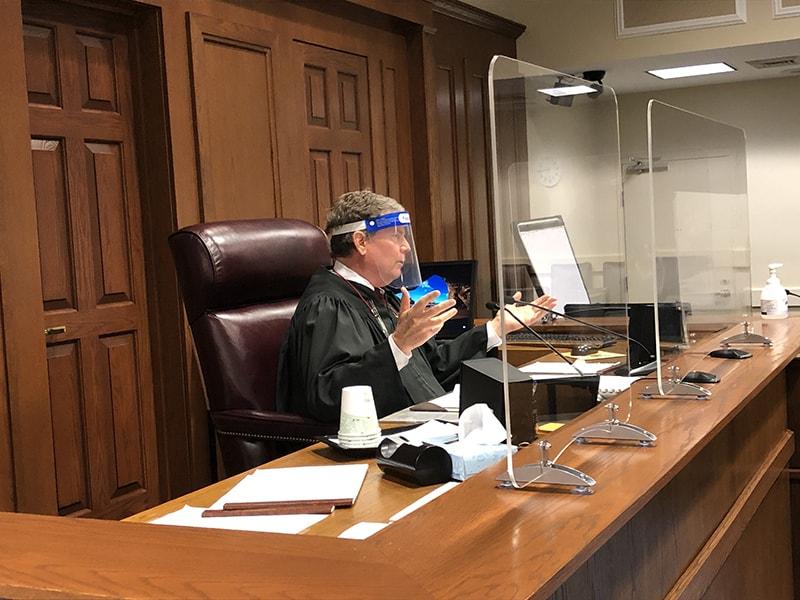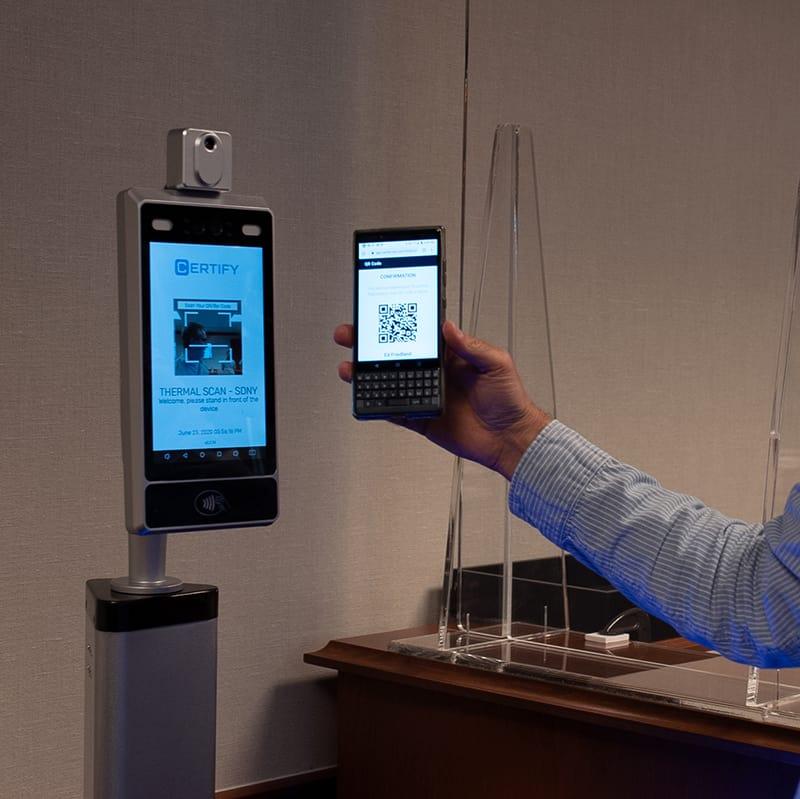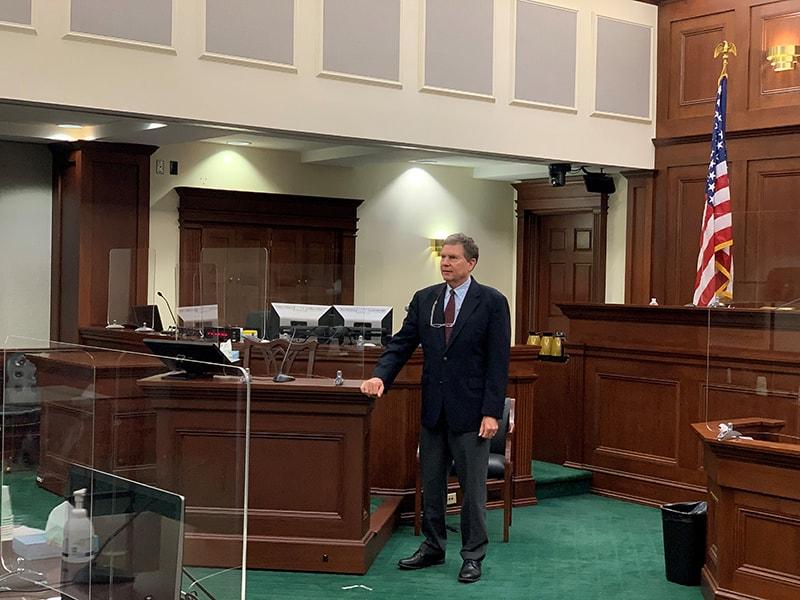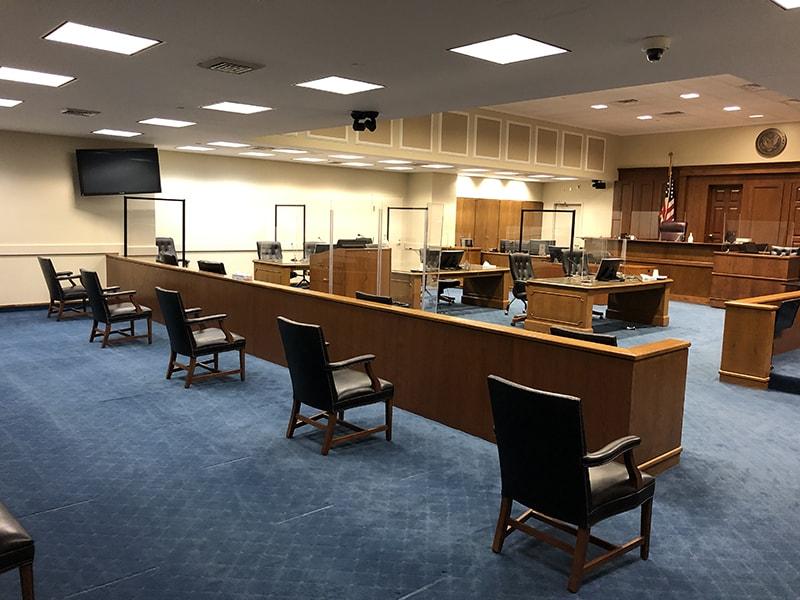This is the first of a multi-part series on how federal courts are working to recover from the COVID-19 crisis.

For more than 230 years, the federal Judiciary has spanned the horseback era to the internet age, but in one key respect it has never changed. Just as in the nation’s earliest years, the Constitution still requires federal courts to conduct many critical legal proceedings in person.
When coronavirus (COVID-19) cases spiked in March, court practices changed almost overnight, relying on virtual hearings that make it possible to conduct most court-related activities without coming to the building. Now, with courts seeking to restore in-person proceedings, one thing already is clear: Justice in a pandemic environment will have a very different look and feel.
“On August 24, when we start our first trials, jurors will enter courtrooms that look nothing like what they would expect,” said Chief Judge James K. Bredar, of the U.S. District Court for the District of Maryland. “Plexiglass shields erected throughout. No public gallery. All participants masked, and lawyers wearing headsets so they look like air traffic controllers. Stand-alone jury chairs spread across the back and one side of the courtroom, all at least six feet apart.”
Like federal judges across the country, Bredar is reinventing his courtroom in an attempt to achieve two vital interests: protecting public health from COVID-19 infection while also ensuring Constitutional rights that date back centuries. Despite obvious risks and public anxieties, he and other judges said they are working through the challenges.
“It’s a balancing act, and a tough one, but balancing acts are not unfamiliar to judges,” Bredar said. “When the proceedings begin, the trials will have a familiar structure and cadence, with counsel making opening statements and presenting evidence in the ordinary, time-honored sequence. At their core, these will still be orderly jury trials, and easily recognized as such.”
New courtroom layouts are among the many ways courts are seeking to limit the risk of COVID-19 infection.
In Manhattan, federal court staff and visitors must now fill out an online health survey and be cleared by a digital temperature reader before they can access the building. In Boston, the District of Massachusetts has begun pre-paying a nearby parking lot, so that members of the public do not have to depend on public transit. In Boise, the court’s air-conditioning system is pumping more air into the building from outdoors, to keep exhaled breath from stagnating.
Courts have moved forward, and sometimes backward, as local COVID-19 caseloads have fallen and then risen again.
In early June, the Northern District of Texas held one of the first federal jury trials since the pandemic threat escalated. The trial unfolded without a hitch, and jurors reported feeling safe, but in early July, additional jury trials in the Dallas courthouse were postponed for the rest of the month as new COVID-19 cases spiked.
“It’s going to be baby steps. We’re all doing the best we can,” said Chief Judge Barbara M.G. Lynn, of the Northern District of Texas. “The ideals of justice and rule of law are vital to our country, and those principles cannot stop. But we need to temper a desire to go full speed ahead with a focus on safety.”
Overshadowing much of the planning by courts is the U.S. Constitution. Even in a health crisis, the Sixth Amendment guarantees rights that must be provided in an open court of law. These include the right to confront accusers and the right to confer confidentially with counsel. Most criticall or texty, jury trials must be conducted in person, and the backlog is rapidly growing.
“We have more than 80 criminal trials waiting, everything since last February,” said Robert M. Farrell, clerk of court for the District of Massachusetts. “We normally have about 20 cases that are trial ready. Starting in September, we plan to have four jury trial courtrooms and one magistrate judge courtroom for initial appearances.”
In their efforts to balance safety and justice, judges and clerks of court say they have gained expertise in such arcane topics as building air flow, and many have consulted with epidemiologists.
In the Southern District of New York, the court’s safety strategy begins, but does not end, with a required health questionnaire and a no-contact digital temperature check for all employees and visitors before they enter the courthouse.
Everyone must wipe their hands with disinfectant, and protective masks are mandatory in all public areas. Elevator ridership is severely restricted, and staff are starting as early as 6 a.m., or as late as 10 a.m., to avoid crowded trains.
“Before employees got on public transportation, there was a lot of anxiety about how commuting was going to work,” said Edward Friedland, district executive for the Southern District of New York. “Those so far who have ridden on public transportation generally have been okay with it.”

While many courts are not requiring formal health screenings, social distancing is nearly universal. That already has posed challenges for minor hearings, involving just litigants and lawyers, who must sit apart from one another.
In addition to plexiglass, some courts have installed audio systems with headsets that enable clients and lawyers to whisper to each other, much as they would in a traditional courtroom, but from a safe distance.
Courts also have wrestled with the question of who must wear masks in the courtroom.
In Colorado, everyone—including lawyers, jurors and witnesses—will be required to wear masks inside the courtroom. The court also will permit witnesses to be examined without masks, via video from a separate jury deliberation room that is not in use.
Many other courts, citing the Sixth Amendment right to confront witnesses, are requiring that witnesses not wear masks while testifying.
“The attorneys were very specific that that’s what they wanted,” said David C. Nye, chief judge of the District of Idaho, which has resumed jury trials. “They wanted to have the jurors see the witness’s face, to assess credibility.”
As in-person courtroom proceedings ramp up, the biggest cost of social distancing is the physical space that it requires. With participants forced to sit six feet apart, courts are using multiple courtrooms for one proceeding. This includes overflow rooms for the public to see or hear courtroom proceedings, and extra space for witnesses and jury deliberation.
An added complication is that many federal court districts have both large urban courthouses and smaller buildings in suburban and rural areas. Each courthouse must develop its own strategy for handling cases.
Read the Series
This is the first in a series of articles about how federal courts are working to recover from the COVID-19 crisis.
Next in this series: Courts overcome challenges to conduct jury trials.
“One size likely will not fit all,” said Mark R. Hornak, chief judge of the Western District of Pennsylvania. “Our physical footprint in each of the divisions is quite different. Proceedings that can occur in our larger buildings may be handled differently, and in a different time frame, than in our smallest physical facility.”
For all the efforts to protect public health, Judiciary leaders acknowledge that the greatest uncertainty is beyond their control. On the question of whether the public, and even court staff, will trust that courthouses will be safe from infection, the jury literally is still out.
Judges and court clerks say that early jury trials have proceeded on schedule, but they are going to great lengths to assure jurors their health will be protected.
Bredar, who on Aug. 24 will preside over the District of Maryland’s first jury trial since March, has commissioned an educational video showing jurors the many steps being taken to make the district’s two courthouses safe. He also says the public needs to know how much they contribute to the delivery of impartial justice.
“For over two centuries, the federal courts have always remained open—through wartime, natural disasters, and even previous pandemics,” Bredar said. “It remains true now, because of the dedication of judges, court staff, attorneys, and members of the public, who dutifully continue to serve as jurors and witnesses.”


